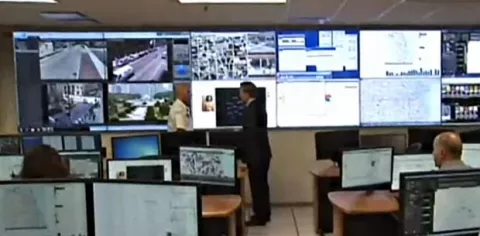
It seems like an odd assortment of issues, but Chicago officials say the Internet of Everything is helping them solve everything from crime and traffic congestion to staffing challenges and pest control.
Chicago got a chance to show off this week at an event sponsored by Council Lead Partner Cisco. During a public sector roundtable, the city outlined how its Internet of Everything efforts have paid tremendous dividends.
Technology helps catch criminals
Perhaps the most visible benefits have been in the area of public safety. Chicago recently made national headlines by winning a conviction against a robber who was caught thanks to facial recognition technology. But the city’s smart policing efforts go far beyond that.
Chicago’s Crime Prevention Information Center first opened in 2007 and was upgraded just last month. The center pulls information from 25,000 cameras, a gunshot detection system and other sources into a central command center where it can be analyzed and acted upon.
Chicago Police Commander Jonathan Lewin says video is useful in two ways. During incidents, live video from any camera in the network can be viewed on screens at the center or on mobile devices by officers in the field. For crime analysis and prevention efforts, officers can review footage from city-owned cameras for up to 30 days.
He says the ability to easily review footage has been a huge benefit to the department as it works on crime prevention.
“We can’t conduct proactive missions if we always have to send someone out to retrieve the video,” Lewin says.
More information available to first responders
Officers aren’t limited to images from the network of video cameras. Another innovative approach is the ability for the public to send emergency dispatchers images from their smartphones. For example, someone who witnessed a robbery could securely send the dispatcher an image of the robber. The dispatcher would then send that image to responding officers.
While officers are on the way to the scene they can also pull up information about past incidents, possibly providing valuable insight that could help them more effectively deal with the current situation. Before, they would arrive on the scene with only the information provided to them by dispatchers.
But the advances also aren’t limited to police officers. With numerous databases feeding into the system, it can also provide firefighters with a building’s floor plan as they’re on the way to the fire call.
Using data to drive efficiencies
Another part of Chicago's strategy involves making use of available data to make city services more effective, and the city says this has already paid off with service improvements and lower costs.
For example, during parades, the city used to have staff on-the-clock sitting and waiting for the parade to conclude before beginning cleanup efforts. Now the city is able to direct the crews to essentially follow the parade. The city is no longer paying for staff downtime and the clean-up is immediate.
The data is also used to make traffic signals smarter, helping to speed drivers home after big city events and ball games.
Analytics have also made Chicago’s pest control much more effective. By analyzing past work orders, there’s much less guesswork as to where rats build nests. While some trouble spots were common knowledge – in the garbage behind restaurants, for example – data analysis identified more trouble areas, including construction sites and areas where trees have been downed or thinned.
With the research, staff now spend more time working directly on the rat problem and less time searching for it. As a result, the city’s bait usage has dropped by a third.
“We are using analytics to prioritize our services and make them more effective,” says Chicago’s Chief Information Officer Brenna Berman.
Embracing third-party development
Chicago has more than 600 data sets available on its open data portal and it is embracing the work of entrepreneurs who are finding ways to make that data useful to the residents.
Berman proudly cites the work of a developer who created an app that helps residents avoid parking tickets. The developer took the city’s street sweeping datasets to build an app that automatically warns residents to move their cars before a street sweeper reaches their block.
And soon even more data will be available. The city plans to install sensors on traffic light poles that track temperature, humidity, air quality, light and noise levels and motion, among other things. The city will make that data available real-time.
Berman says about a dozen companies are using the available data sets now for economic gain, and there have been some in government who wonder why the city is giving that data away instead of charging those companies a fee to use it.
“We believe (the data) is the property of the Chicago taxpayers,” she says. “It’s not ours to sell.”
###
Get Smart Cities Now, our weekly newsletter highlighting smart city trends, technologies and techniques. It's just one of the benefits you receive by joining the Smart Cities Council (and your membership is free).



